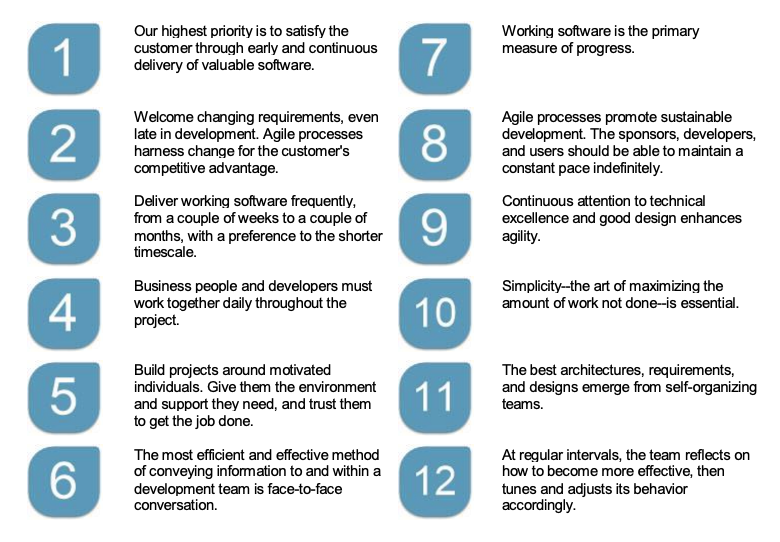Agile Manifesto
by Humphreys & Associates | August 6, 2019 10:00 am
Agile Alliance
On February 2001, seventeen people convened at the Snowbird Ski Resort in Utah to find common ground and develop an alternative approach to document-driven, heavyweight software development processes. The group included representatives from Extreme Programming, SCRUM, DSDM, Adaptive Software Development, Crystal, Feature-Driven Development and Programmatic Programming. They named themselves the “Agile Alliance” and created and signed the Agile Manifesto which became the cornerstone for the Agile movement.
Manifesto for Agile Software Development
We are uncovering better ways of developing software by doing it and helping others do it.
Through this work we have come to value:
Individuals and Interactions over Processes and Tools
Working Software over Comprehensive Documentation
Customer Collaboration over Contract Negotiation
Responding to Change over Following a Plan
That is, while there is value in the items on the right, we value the items on the left more.
Agile Streamlines Documentation
Historically, enormous amounts of time were invested in documenting the product for development and delivery. The list was extensive and included technical specifications, requirements, prospectus, interface design documents, test plans, documentation plans, and untimely approvals, resulting in bottlenecks and long cycle times. Agile does not eliminate documentation, rather, it streamlines documentation by providing the developer with just the essentials that are needed to do the work.
People Over Process
Valuing people more highly than processes or tools is easy to understand because it is people who respond to business needs and drive the development process. If the process or the tools drive development the team is less responsive to change and less likely to meet customer needs.
Negotiation vs. Collaboration
Negotiation is the period when the customer and the product manager work out the details of a delivery with points along the way where the details may be renegotiated. Collaboration is a different creature entirely, with development models such as waterfall, customers negotiate the requirements for the product often in great detail prior to any work starting.
This meant the customer was involved in the process of development before development began and after it was completed but not during the process. The agile manifesto describes a customer who is engaged and collaborates throughout the development process, making it much easier for developers to meet the needs of the customer.
Welcoming Change
Traditional software development regarded change as an expense and avoided it whenever possible. The intention was to develop detailed elaborate plans with a defined set of features and dependencies so that the team had a clear understanding of what should be developed and when it should be worked.
Agile welcomes changing requirements, even late in the development and uses rolling wave planning to decompose work just-in-time, without going into elaborate decomposition of the high-level plan.
12 Principles
The Agile Alliance also created 12 principles that support and expand on the four agile manifesto values. These principles have resulted in a number of widely accepted best practices that are used in many agile approaches such as extreme programming, scrum, DSDM, Adaptive Software Development, Crystal, and Feature-Driven Development.
The Agile Manifesto has spread like wildfire since 2001, forever altering the way we develop custom solutions and making impacts far beyond its original software origin.

Source URL: https://blog.humphreys-assoc.com/agile-manifesto/